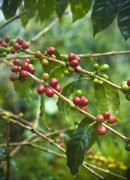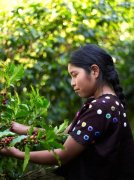Roasting degree of espresso beans: deep roasting? Re-baking? Shallow baking?
Roasting degree of espresso beans: deep roasting? Re-baking? Shallow baking?
As mentioned above, Italian concentration, as a method of extraction, is characterized by pressure extraction, that is, water flows through coffee powder under high pressure to achieve flavor extraction.
Pressure extraction will highlight the flavor, such as sour coffee beans, pressure extraction, the intensity of the sour taste will be increased.
As mentioned above, the traditional Italian concentrate pursues a balance of coffee taste. Deep roasting, which usually refers to roasting in the second explosion stage, helps to reduce the acidity of the coffee bean itself, thus better balancing the taste.
In addition, another major feature of Italian concentrated extraction is rapid extraction, compared with other extraction methods, such as hand coffee extraction time of a few minutes, Italian concentrated extraction is usually completed between 20-30 seconds. Deep-roasted coffee beans have more fluffy tissue, and when in contact with the current, the dissolution of high-quality flavor is easier to achieve at the same time.
Based on the above two reasons, that is, to reduce the inherent sour taste to achieve taste balance, and to improve the extraction efficiency to achieve the acquisition of high-quality flavor in a short time, most of the coffee beans used in Italian concentration are deep-roasted beans in the second explosion stage.
Deep roasting or heavy roasting depends more on flavor preferences. For example, the traditional view is that espresso prevails in Italy, with different roasting degrees from south to north. In addition, another important area for the development of espresso, the United States, the west coast is also different from the east coast. In the most classic re-baking plot, it has been mentioned in many books that during the most popular period of re-baking, many bakers used three explosions of beans to prevent coffee beans from becoming black charcoal.
As for the trend of shallow roasting, it should also be related to the promotion of boutique coffee culture. in the era of boutique coffee, bakers pay attention to the prominence of the flavor of the producing area, and deep roasting will cause the loss of the original flavor of raw beans, so the degree of roasting begins to be reduced. In addition, based on the taste preference, the baker will also choose to reduce the baking degree and retain moderate acidity.
What's more, in the era of boutique coffee, the pursuit of origin flavor, the understanding of Italian coffee flavor is also more diverse, in addition to the traditional balanced taste, according to the baker's understanding, Italian concentrated flavor performance is more diverse, such as the classic sweet confluence, such as the emergence of Italian concentrated drinks with a single bean to highlight flower flavor and fruit flavor.
To sum up, the traditional Italian concentration tends to the second explosion and above the deep roasting degree, in the era of boutique coffee, the choice of roasters is more diverse.
3. The taste of espresso: bitter? Sour?
As mentioned earlier, traditional espresso pursues a balance of tastes. for example, the increasingly well-known World Barista Competition judges the taste of espresso if the barista does not make a special statement. the flavor of Italian concentrate takes balance as the expected flavor. At the same time, it is also pointed out that the focus of today's espresso flavor tasting is that the flavor performance of a cup of espresso depends on the roaster and barista's grasp of the taste. If you want to really taste a certain espresso, you need to consult the barista, or, in some cases, the barista needs to give the necessary explanation to the customer if he wants to convey the flavor of his own espresso.

To sum up, the traditional flavor of espresso is balanced, and the specific taste performance needs to be combined with the store's grasp of the taste.
Important Notice :
前街咖啡 FrontStreet Coffee has moved to new addredd:
FrontStreet Coffee Address: 315,Donghua East Road,GuangZhou
Tel:020 38364473
- Prev

African Coffee and Raw Bean Merchants Caf é in Chipinga, Zimbabwe (Zimbabwe)
1. A variety of fine coffee. It is better to use Arabica inherent variety Tibica or bourbon variety. two。 Is the altitude, topography, climate, soil and refinement of the cultivated land or farm clear? Generally speaking, the coffee with high altitude is of higher quality, and the fertile volcanic soil is the best. 3. The harvesting method and refining method are adopted. Generally speaking, manual harvesting method and washing essence are adopted.
- Next

Premium Tanzanian beans Kilimanjaro and Meru Mountain Medium Roast Coffee Machine
1. Fine coffee varieties. Arabica native varieties Tibica or Bourbon varieties are preferred. 2. Is the altitude, terrain, climate, soil, and refining method of the cultivation site or farm clear? Generally speaking, the coffee quality at high altitude is higher, and the soil is better with fertile volcanic soil. 3. The recovery method and refining method adopted. In general, manual recovery methods and water washing methods are used.
Related
- Does Rose Summer choose Blue, Green or Red? Detailed explanation of Rose Summer Coffee plots and Classification in Panamanian Jade Manor
- What is the difference between the origin, producing area, processing plant, cooperative and manor of coffee beans?
- How fine does the espresso powder fit? how to grind the espresso?
- Sca coffee roasting degree color card coffee roasting degree 8 roasting color values what do you mean?
- The practice of lattes: how to make lattes at home
- Introduction to Indonesian Fine Coffee beans-- Java Coffee producing area of Indonesian Arabica Coffee
- How much will the flavor of light and medium roasted rose summer be expressed? What baking level is rose summer suitable for?
- Introduction to the characteristics of washing, sun-drying or wet-planing coffee commonly used in Mantenin, Indonesia
- Price characteristics of Arabica Coffee Bean Starbucks introduction to Manning Coffee Bean Taste producing area Variety Manor
- What is the authentic Yega flavor? What are the flavor characteristics of the really excellent Yejasuffi coffee beans?

